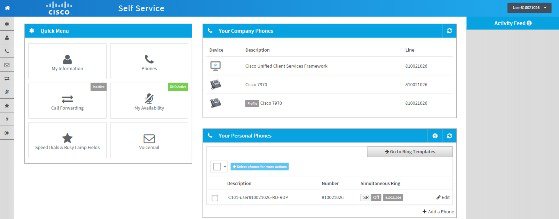Contents
Dashboard
Dashboard
This screen provides a summary of your specific Self Service configuration. The following figure shows a sample Dashboard.

The Quick Menu provides links to:
-
My Information—Displays your personal information such as user ID, names, telephone numbers, and email address. Also indicates whether you have passwords and PINS configured for Self Service, Cisco Unified Communications Manager, and Voicemail.
-
Phones—Displays your configured company phones (and associated lines).
-
Call Forwarding—Displays the call forwarding status of your phone lines. A green ‘Active’ flag indicates that one or more of your phone lines has call forwarding activated (enabled).
-
My Availability—Displays the do not disturb status of your phone lines. A green ‘DND Active’ flag indicates that one or more of your phone lines has the do not disturb feature activated (enabled).
Speed Dials & BLFs - Displays the speed dial and busy lamp field configuration (if configured) for each of your company phones.
-
Voicemail—Displays the configured time zone and language settings for your Voicemail account. These settings are only visible if you have a Voicemail box.
Your Company Phones—lists the company phones allocated to you by your administrator. See Phones for more information on how to view and manage your company phones.
Your Personal Phones—lists the personal phones that you configured, such as home phone, mobile phone, and so on. Personal phones can also be configured (if required) to ring whenever a company phone rings. You can also edit existing personal phones (by configuring them to ring simultaneously with your company phones), or add new phones if required. This feature is only available (and visible) if your administrator has allocated a remote destination profile (RDP) to you. Note also that multiple RDPs per user is not supported. If you are associated with multiple RDPs, the personal phones feature is hidden. If a dual mode device, such as the Cisco Dual Mode for Android or iPhone, is associated to you, you can manage both the phone number and simultaneous ring setting for the device. See Add a Personal Phone, Edit a Personal Phone, and Delete a Personal Phone for more information on each respective task.